Archive for August, 2015
Apple II Copy Protection
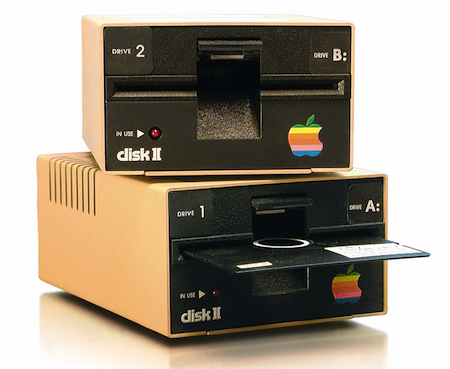
Growing up during the heyday of Apple II computers, I learned about something mysterious called copy-protection. This meant floppy disks could be used to run software, but the software couldn’t be copied to other floppy disks. As a 10-year-old nerd, this left me confused. Running a game or other piece of software required reading the data from the disk. Copying the disk required reading that same data, then writing it back to another disk. How could it be possible for a floppy to be readable when running a program, but not readable when copying the program? It didn’t seem to make sense.
Years later I learned more about copy-protection, and my experiments with Floppy Emu have also provided insights into floppy-specific copy protection methods. It’s fascinating stuff, so let’s look at it! We’ll begin by examining how Apple II floppy disk access works in the normal case, then we’ll see some of the abnormal tricks that were used to implement copy protection. We’ll also look at how floppy access on the original Macintosh differed from the Apple II, and how this affected copy protection.
Floppy Fundamentals and Limitations
A floppy disk is a wheel-shaped disc of magnetic media with a hole in the center. The data is stored in a series of concentric circles, called tracks. Unlike the single spiral groove on a phonograph record, each track on a floppy disk loops back onto itself, and does not intersect or overlap the other tracks. The disk spins continuously with a constant speed and direction, while a stepper motor moves the read/write head inward and outward as needed. To access a specific piece of data, the head must step in/out until it’s over the correct track. To find the desired information, the computer then begins reading data from the track, starting with whatever portion of the track happened to be passing under the head at that moment. It keeps reading until it recognizes a marker for the desired information, then it reads the information itself immediately afterward. The access time is the sum of the time needed to position the head over the proper track plus the time needed to wait until the desired data passes under the head (on average, half a rotation of the disk).
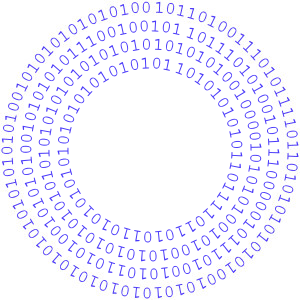
On an Apple II floppy disk, a track is just a circular buffer of about 50,000 bits, with nothing to mark its beginning or end. Even the boundary between one byte and the next is unknown, so framing the bitstream into bytes correctly requires additional work. The disk controller must rely on the first fundamental rule of Apple floppy disks: the most significant bit of a disk byte must always be 1. If at any time the disk controller reads a byte whose MSB is not 1, then the byte framing must be wrong. Adjust the framing by one bit, and try again.
The disk controller must also honor the second fundamental rule of Apple floppy disks: a disk byte may contain no more than two consecutive zero bits. While the first rule is an arbitrary choice to make framing easier, the second rule is a physical limitation imposed by the way data is encoded magnetically. A 1 bit is stored as a reversal of the magnetic polarity on a region of the disk, while a 0 bit is stored as no reversal of magnetic polarity in that region. With too many consecutive zero bits, you’ll get too large of an area with no magnetic reversals. I’m unsure exactly what problem this leads to – the magnetic field in that region becomes too weak, or the read circuitry loses synchronization maybe – but the end result is that it’s forbidden to have more than two consecutive zeroes.
GCR Encoding
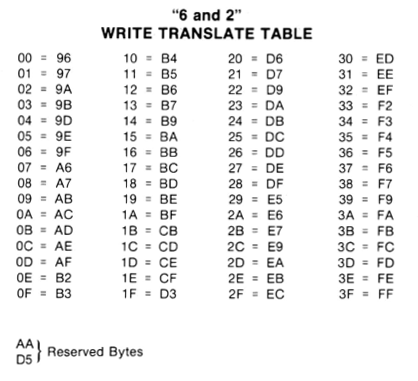
But wait a minute: if the MSB must always be 1, and consecutive zeroes are limited to two, that rules out more than half of all possible byte values. How can you store arbitrary data on a floppy disk, if more than half the possible byte values are forbidden? The answer is that program data and files aren’t stored directly on the floppy disk. Instead, their bytes are encoded in a process that converts logical bytes to disk bytes. On the Apple II, this process is called 6-and-2 Group Code Recording, or just GCR for short. There are 66 possible byte values that satisfy fundamental rules 1 and 2. Setting aside two of these as reserved, this leaves 64 possible disk byte values: enough to encode 6 bits of logical data with a lookup table, because 2 ^ 6 = 64. This means that every three bytes of logical data (24 bits total) will be stored on the floppy disk as four bytes of disk data (one of 64 possible values per byte, so 6 bits per byte, 24 bits total). Thus, data undergoes an expansion of 33% in size when it’s stored on a floppy disk.
Sectors
By itself, the GCR encoding scheme isn’t enough to build a working floppy-based file system. We also need some way to identify where a track begins, and where specific pieces of data lie within a track. On the Apple II, a track is divided into 16 sectors, with 256 bytes of logical data per sector (342 actual disk bytes due to the 33% GCR overhead). The start of each sector is marked with the magic byte sequence D5 AA 96. Because two of those magic bytes are the two reserved values that meet rules 1 and 2 but aren’t used for GCR, this sequence is guaranteed never to occur in the middle of other encoded data. After this sequence lies a few other bytes of header data: the sector number, track number, etc, and then (glossing over some details) the sector data itself. After the sector data, there’s a checksum and another magic sequence to mark the end of the sector.
It’s important to realize that sectors are just arrangements of data in a track. There’s no physical boundary that separates them, and nothing special about them except that they’re regions of data marked with certain magic bytes. Normally the last byte of a sector is not followed by the first byte of the next sector, but instead, there’s a series of so-called self-sync bytes between them. The sync bytes don’t contain any information, but they’re organized in a way that takes advantage of fundamental rule #1: the MSB of a disk byte must always be 1. No matter where the disk controller begins reading and framing bytes in the middle of a series of sync bytes, it will always end up with the correct byte framing after reading at most 5 sync bytes. So a standard floppy disk will always have at least 5 sync bytes between the bytes of two consecutive sectors.
If you search the web for illustrations of a floppy disk’s tracks and sectors, you’ll find lots of diagrams like this:
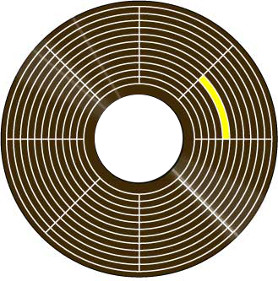
That diagram is misleading in several respects. On a real floppy disk, the sectors in each track aren’t aligned with those in the neighboring tracks, but instead each track is staggered from the next by some random amount. Sectors in the same track aren’t immediately adjacent to each other either – there’s actually a small gap between one sector and the next. Nor are tracks truly adjacent to each other. A real floppy has unused space between one track and the next outer and inner tracks. Here’s a better diagram of a hypothetical three-track floppy disk, showing the stagger offset between sectors in adjacent tracks, the inter-sector gap, and the space between tracks:
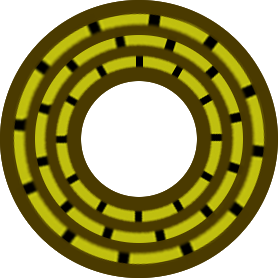
Booting from Floppy
When you insert a floppy disk, and reset the Apple II or type PR#6, a small piece of code is run from the disk controller’s ROM. This code knows how to step the head to track 0, look for D5 AA 96, and examine sector headers to find sector 0. Once it finds it, it loads 256 bytes of data from sector 0 into memory, assumes that this data is executable code, and runs it. What happens after that depends on the software, and the code that was loaded from sector 0. Normally this bootstrap code will load additional code and data from other sectors on the disk, until the whole program is loaded and ready to run.
Copying a Floppy (or not)
A simple disk copy program assumes that the floppy being copied is organized in the standard way: 35 tracks, 16 sectors per track, 256 bytes per sector, with a particular checksum algorithm, and D5 AA 96 marking the start of each sector. It attempts to read the data from each sector into memory, then it writes the same data out to a new floppy disk. If anything goes wrong during reading the sectors from the original disk, the copy process will fail.
The crux of copy-protection is this: the bootstrap code loaded from sector 0 has total control over the floppy disk drive and the way the data in other sectors is encoded. Only sector 0 must be encoded and stored in the normal way, so that the initial ROM routine can load it. Thereafter, the software’s bootstrap code has no obligation to follow the standard conventions for track layout, GCR encoding, sector marker magic sequences, or anything else. In fact, pretty much everything is up for grabs.
When this sector 0 bootstrap code is running with the original floppy disk, it knows how to find and load data from the other sectors, using whatever tricky mechanisms the developers used to tweak the standard organization of a floppy disk. But when a disk copying program is running, it sees sector 0 as just part of the data to be copied, and it attempts to copy all the other sectors using the standard methods too. If the copy-protection is good, this attempt will fail, because a sector checksum somewhere will appear invalid, or a sector can’t be found on the track where it was expected, or some other similar problem. Or in some cases the copying will appear to succeed, but then the copied disk won’t work.
The art of cracking copy-protected software involves examining the code stored in sector 0, and analyzing it to understand how it works. With persistence, this will reveal what tricks were used to obfuscate the data in the other sectors. The cracker can then deobfuscate the data, and create a new non-protected floppy disk using the standard disk methods.
Data Tweaks
The easiest way to defeat a simple disk copy program is to alter the sector data in some way that’s consistent, but different from the standard.
Magic Bytes: Who says D5 AA 96 must mark the start of a sector? A copy protected disk might use D5 D5 96, or some other sequence that works just as well, assuming you’re looking for it. But a simple disk copy program will only be looking for D5 AA 96, so it will never find the start of those sectors. It will appear as if the disk is empty.
Checksums: Each Apple II sector is checksummed using a simple algorithm. (See the book Beneath Apple II DOS if you’re curious.) But there’s nothing magic about that algorithm, and a copy protected disk might use another. To the sector 0 bootstrap code, this would be no problem as long as it knew how to compute the new checksum. But to a disk copy program, it would appear as if every sector had a checksum error, and the disk was corrupted.
Bad Sectors: A bad sector that was never intended to be read might be intentionally placed on the original floppy. The program code would know to ignore this sector and not even try to read it, but a disk copy program would try to copy it, and fail.
Duplicate Sectors: Multiple copies of the same sector might be placed in a track, with each copy offset by 90 or 180 degrees along the track’s circumference. These duplicate sectors would contain different contents. Depending on where the head was located within the track when the computer began looking for the sector, it might read any of the copies. On the original floppy disk, repeated reads of that sector would therefore appear to return different results. But a copy of the original disk would contain only one instance of the sector, and so would always return the same result. The bootstrap code could use this difference in behavior to detect whether the floppy were original or a copy.
Sector Size: How about 512 bytes per sector instead of 256? To a standard disk copy program, it would be unintelligible.
More: Offset the sector numbers by some constant delta, insert a pad byte somewhere, disguise the headers with an XOR trick…
Hidden Data
Normally the bytes between the end of one sector and the start of the next are just self-sync bytes. But what if you stored a magic byte sequence in there, and added a routine to the bootstrap code to verify it’s there? A standard disk copy program will only copy the contents of the sectors, and not the apparently useless sync bytes between the sectors. So the copy will appear to succeed, but the copied disk won’t run correctly because the check for the magic byte sequence will fail.
Encoding Tweaks
GCR uses a standard lookup table to convert six bits of logical data into a disk byte, and also to do the reverse translation. But who says a copy-protected program has to use the standard GCR table? Or for that matter, who says it has to use GCR at all? A clever copy-protection designer could use any method he wanted to encode logical bytes as disk bytes, as long as rules 1 and 2 are still satisfied. But a different encoding method from the standard would be unintelligible to most disk copy programs.
Track Hacks
There are 35 tracks on a standard Apple II floppy disk: 35 concentric circles that store data. But the positions and radii of these circles are arbitrary, and there’s no physical track structure on the disk media. Instead, the media is just one continuous piece of magnetic material. Tracks are packed as close to each other as possible, up to the limit where the magnetic field of one track would interfere with its neighbors if they were any closer. An interesting detail: the stepper motor that moves the drive head has a 4x higher resolution than the distance between tracks. It takes four steps of the head to move from one data track to the next. So on a standard floppy disk, if the head is on track 0, it must go step-step-step-step to reach track 1, then step-step-step-step to reach track 2, etc.
So what happens if you’re at track 1, and the drive goes step-step? Where is the head now? It’s on a region of the floppy disk halfway between where track 1 and track 2 are normally stored, which we’ll call track 1.5. You can’t store any data at track 1.5 without interfering with data in track 1 and track 2, because they’re too close together. But a clever copy-protection author can sacrifice a little bit of disk capacity in order to store hidden data in these intermediate non-integer numbered tracks. For example, there might be data on tracks 1, 2, 3, 4.5, 6, 7, 8 etc. A standard disk copy program would see no data on tracks 4 and 5 where it expected it, and it would overlook track 4.5 entirely. Sneaky! The same technique can also be used to make quarter tracks, like track 3.25.
Half and quarter tracks could also be used to measure position dependencies between data in adjacent tracks. For example, during mastering of the original disk, the drive might write a few sectors to track 1, then step to track 1.25 and immediately write more. As long as the track 1.25 sectors didn’t occupy the same part of the track perimeter as the track 1.0 sectors, there would be no magnetic interference. When running the software, the bootstrap routine could read the sectors from track 1, then step to 1.25 immediately after the last sector, and verify that the next thing on track 1.25 was the expected additional sectors. Even a special disk copying program that could handle quarter tracks would have trouble with this, because the relative positions of sectors in tracks 1.0 and 1.25 would not be preserved in the copied disk.
You Big Cheater!
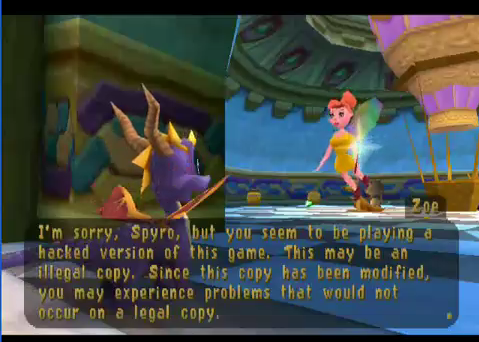
Many Apple II games appeared to copy successfully, but if you ran the copy, you would eventually reach some kind of roadblock complaining “you stole this game!” or otherwise chastising you for making a copy. It’s not hard to see how this might have been done. If we assume the game’s critical initialization code is in sector 1, there might be two copies of sector 1 on the original floppy disk. The real version might have a non-standard sector marker like D5 D5 96, and the decoy version would have the standard sector marker D5 AA 96. A standard disk copy program would copy the decoy version of sector 1 and ignore the real version. If the decoy version contained code to display a “you big cheater” message, it would be displayed when you attempted to run the game from the copied disk.
Macintosh Copy Protection
Although the original Macintosh used a different size and capacity of floppy disk than the Apple II, it still employed a very similar sector structure, with the same GCR encoding method and D5 AA 96 magic sequence to mark the beginning of each sector. In theory, the same types of copy protection tricks used on the Apple II could also have been used on the Macintosh, but in practice relatively few Macintosh programs were copy protected.
Strike 1 against Macintosh floppy-based copy protection: The floppy disk drive on the Macintosh was not capable of quarter or half stepping. This ruled out all the sneaky fractional track methods of copy protection.
Strike 2: The API routines that were used to read and write data from a floppy were considerably more complex on the Mac than the Apple II, and unlike the Apple II, their source code listings were not published. The Mac floppy I/O routines were also asynchronous, designed to run simultaneously with other activity on the mouse, keyboard, or serial port. Embedded in these routines were all the assumptions about D5 AA 96, checksums, sector sizes, and so forth. It would have been possible for a program to bypass all these routines and access the floppy controller (IWM chip) directly, and do the same kind of data or encoding tweaks that were common on the Apple II. But the complexity of the task and the difficulty of multitasking floppy access with mouse and serial port meant that few developers attempted it.
Strike 3: Two years after the introduction of the Macintosh, SCSI hard disks were introduced, and customers began to expect that all software would be installed to their hard disk rather than running directly from the floppy. A program that used floppy-based copy protection would make that impossible, angering customers and hurting sales.
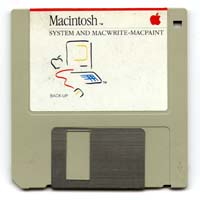
Story Time!
Did you ever work on a copy protection system on the Apple II or another vintage computer system, either as the copy protection developer, or as a cracker? Did I overlook any especially sneaky methods of copy protection, or botch my explanation somewhere? Please leave a note in the comments below, let’s hear your story!
Read 32 comments and join the conversation

